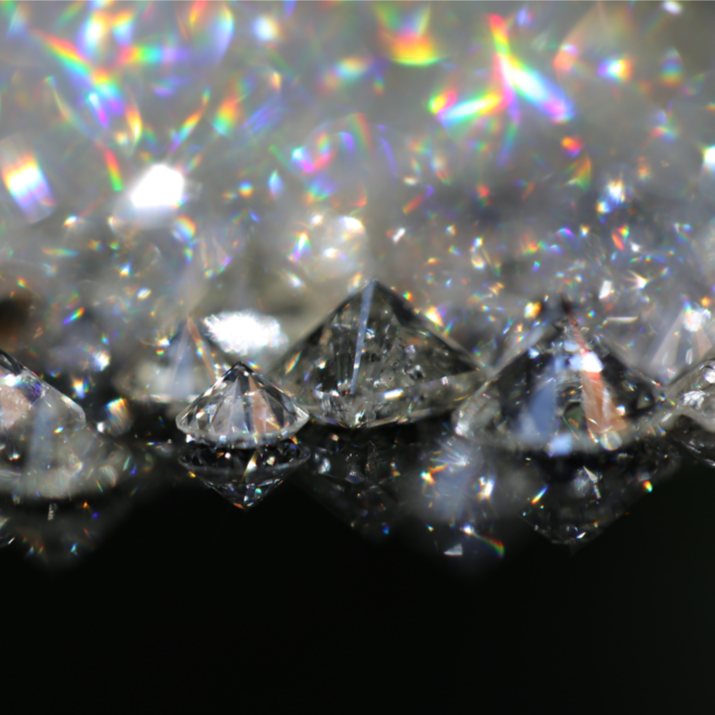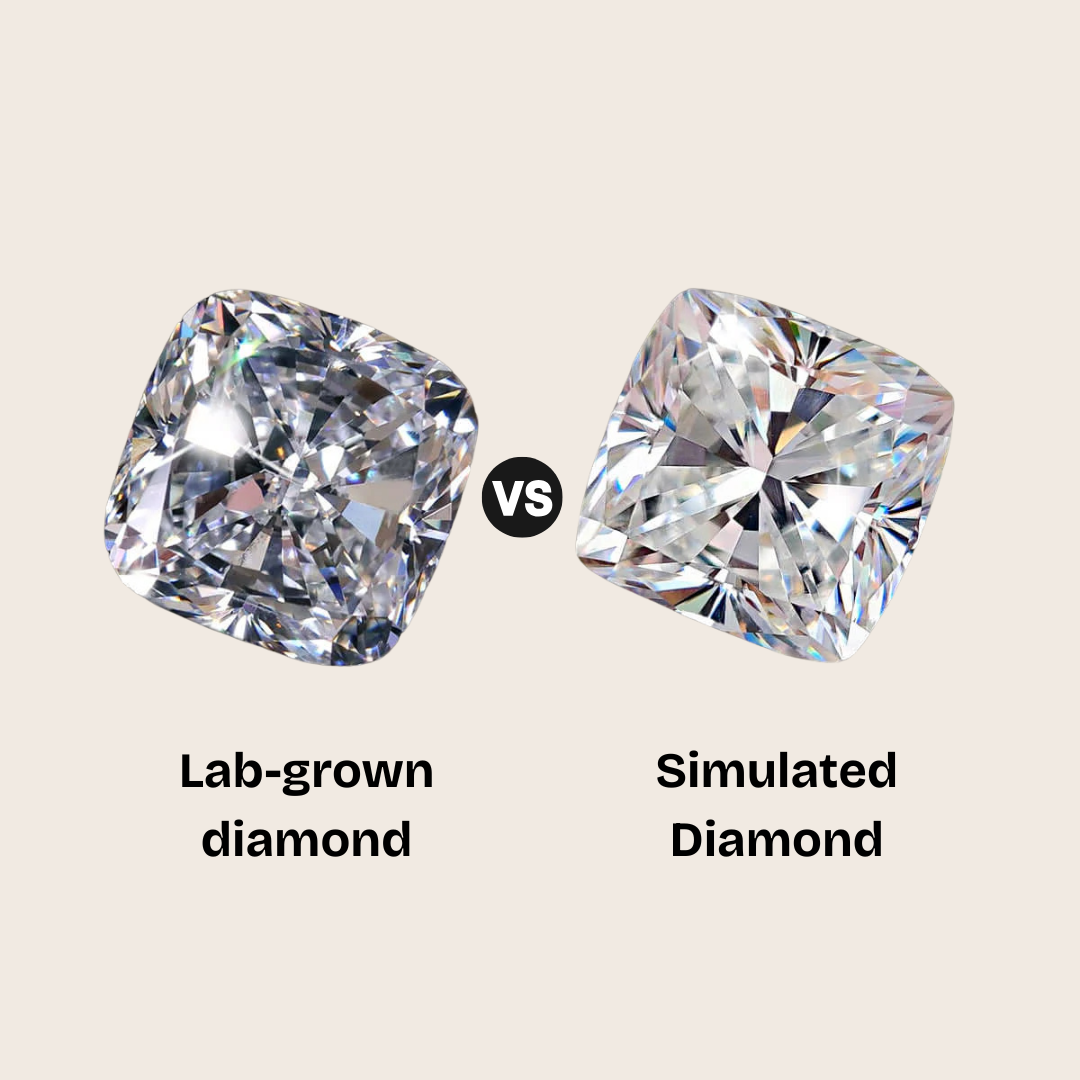IN THIS GUIDE:
- What Are Simulated Diamonds?
- Diamond Alternatives Comparison Table
- Pros and Cons:The Honest Truth
- Simulated vs Lab-Grown Diamonds

What Are Simulated Diamonds?
The Official Definition
The Gemological Institute of America (GIA) puts it simply. Simulated diamonds look like diamonds but have completely different properties. They're not diamonds at all.
Lab-grown diamonds? Those are real diamonds made in labs. Simulated diamonds? They're totally different materials trying to look like diamonds.
Here's the breakdown:
- Natural diamonds: Pure carbon formed deep in the Earth
- Lab-grown diamonds: Real diamonds made with technology
- Simulated diamonds: Various materials pretending to be diamonds
The Science Part (Don't Worry, We'll Keep It Simple)
Simulated diamonds are made from different stuff. They might sparkle like diamonds, but their molecular structure is completely different. This changes everything about how they look and last over time.
Bottom line: simulated diamonds aren't real diamonds. They're copies designed to look like diamonds for way less money. But they can't match a diamond's hardness, sparkle, or fire. Not even close.
Types of Simulated Diamonds
Let's break down the main players in the simulant game.
Cubic Zirconia (CZ)
CZ is everywhere. It's the most common diamond look-alike you'll find.
What you need to know:
- Hardness: 8-8.5 (diamonds are 10)
- Weight: Heavier than diamonds
- Sparkle: Pretty good, but missing that diamond fire
- Durability: Gets scratched and cloudy fast
Price: $10-50 per carat
Best for: Costume jewelry, vacation wear, or when you might lose it
Moissanite
Here's where things get interesting. Moissanite actually sparkles more than diamonds sometimes. It throws off rainbow flashes that can be pretty spectacular.
The specs:
- Hardness: 9.25 (really durable)
- Fire: Better than diamonds (those rainbow flashes)
- Sparkle: Seriously impressive
- Heat: Won't get damaged by heat
Price: $300-800 per carat
Care: Clean it with soap and water. That's it. It'll look good forever if you treat it right.
White Sapphire
White sapphire is the quiet option. It's more subtle than the flashy alternatives.
Two types:
- Natural: Mined from the earth with natural flaws
- Synthetic: Made in labs, usually clearer
What to expect:
- Less sparkly than diamonds or moissanite
- Understated elegance
- Very clear in synthetic versions
Good :
Super durable (9 on hardness scale) You can get natural stones
Not so good:
Not as brilliant as other options
Can look cloudy without proper care
The Budget Options
Glass and YAG exist. They're cheap. Really cheap.
When you might use these:
- Very short-term wear
- Costume parties
- When you need rock-bottom prices
- Practice jewelry
Reality check: These don't last. We're talking weeks or months before they look terrible.
| Factor | Cubic Zirconia (CZ) | Moissanite | White Sapphire | Other Simulants | Lab-Grown Diamonds |
|---|---|---|---|---|---|
| Chemical Composition | Zirconium dioxide (ZrO₂) | Silicon carbide (SiC) | Aluminum oxide (Al₂O₃) | Various (glass, YAG, etc.) | Pure carbon (C) |
| Hardness (Mohs Scale) | 8 – 8.5 | 9.25 | 9 | 5 – 7 | 10 |
| Refractive Index | 2.15 – 2.18 | 2.65 – 2.69 | 1.76 – 1.77 | 1.5 – 2.0 | 2.42 |
| Fire / Brilliance | Good brilliance, limited fire | Exceptional fire | Subtle brilliance, minimal fire | Poor to fair | Exceptional (same as natural) |
| Cost per Carat | $10 – $50 | $300 – $800 | $100 – $400 | $5 – $100 | $800 – $3,000 |
| Durability | Prone to scratching and clouding | Excellent | Very good with care | Poor to fair | Excellent |
| Weight | 1.7× heavier | 12% lighter | Similar | Varies | Identical |
| Heat Resistance | Good | Excellent | Excellent | Poor to fair | Excellent |
| Resale Value | Minimal ($5–$20) | Low ($50–$200) | Low ($30–$100) | None | 40–60% of price |
| Professional Detection | Easily detected | Detectable | Easily identified | Obvious | Needs special tools |
| Certification | Basic certs | GIA for moissanite | Limited | None | Full GIA/IGI |
| Best Use Cases | Costume, temporary | Fashion, alt. engagement | Elegant, subtle wear | Very short-term | All fine & engagement |
| Maintenance | Frequent | Minimal | Regular | High | Minimal |
| Longevity | 6 mo – 2 yrs | Lifetime | 5–10+ yrs | Weeks–Months | Lifetime |
| Ethical Considerations | Conflict-free | Conflict-free, eco | Synthetic, conflict-free | Low impact | Eco & conflict-free |
The bottom line: Simulated diamonds are cheap. Lab-grown diamonds give you real diamond properties for much less than natural diamonds. If you want something that'll last and hold value, lab-grown wins hands down.
Pros and Cons: The Honest Truth
Advantages of Simulated Diamonds
- The price is right This is the big one. You can get a huge stone for practically nothing.
- Sleep well at night No conflict diamonds. No environmental guilt. Buy with a clear conscience.
- Options galore Want maximum sparkle? Go moissanite. Tight budget? Try CZ. Prefer subtle? White sapphire's your friend.
- Cheaper insurance Lower value means lower insurance costs. Perfect for everyday wear.
- Fashion freedom Try trendy styles without the financial stress. Experiment all you want.
Disadvantages of Simulated Diamonds
- Zero investment value Don't kid yourself. These won't hold value. Consider them like clothes or shoes.
- They wear out Most simulants are softer than diamonds. Expect scratches, chips, and dullness over time.
- Social stuff matters Some situations expect real diamonds. Engagement rings especially. Know your audience.
- Hard to sell Good luck finding someone to buy your used simulants. The resale market barely exists.
- Experts can tell Any trained jeweler will spot a simulant immediately. Keep that in mind.

Simulated vs Lab-Grown Diamonds
When you're looking at diamond alternatives, lab-grown diamonds hit a sweet spot. They're real diamonds made in labs instead of mined from the earth.
Why lab-grown diamonds rock:
- Same hardness, sparkle, and fire as natural diamonds
- Cost 30-50% less than natural diamonds
- Get full GIA and IGI certifications
- Last forever without getting dull or scratched
- Totally eco-friendly
Read about the environmental benefits of lab-grown diamonds to learn more.
When simulants make sense:
- Fashion jewelry you'll wear occasionally
- Super tight budgets
- High-loss-risk situations (travel, sports)
- Costume or theater use
Explore Lab-Grown Diamond Jewelry
FAQs
Not exactly. They're real materials that look like diamonds. Think of them as diamond impersonators rather than fake diamonds. They exist and have their own properties.
Depends who's looking. Your friends probably won't know. A jeweler will spot it in seconds. The quality of the simulant matters too.
It varies wildly. Moissanite can last forever if you care for it. CZ might look rough after a few months of daily wear. Most simulants need babying compared to real diamonds.
Absolutely. They have tools specifically designed to identify simulants. Thermal testers, electronic diamond testers, visual inspection. They'll know immediately.
That's totally up to you and what you need. For costume jewelry, fashion pieces, or tight budgets? Sure. For engagement rings or family heirlooms? Lab-grown diamonds make way more sense.
About the Author: This guide was written by Oggi, our jewelry expert. She has over 10 years of experience in precious metals and gemology.
Our team regularly consults with master jewelers and metallurgists to ensure we provide the most accurate, up-to-date information on jewelry metals and trends.
Last Updated: May 2025





